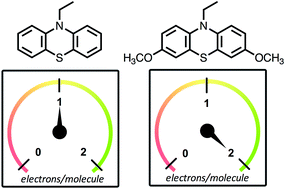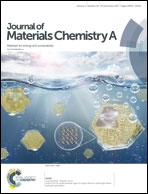A stable two-electron-donating phenothiazine for application in nonaqueous redox flow batteries†
Abstract
Stable electron-donating organic compounds are of interest for numerous applications that require reversible electron-transfer reactions. Although many organic compounds are stable one-electron donors, removing a second electron from a small molecule to form its dication usually leads to rapid decomposition. For cost-effective electrochemical energy storage utilizing organic charge-storage species, the creation of high-capacity materials requires stabilizing more charge whilst keeping molecular weights low. Here we report the simple modification of N-ethylphenothiazine, which is only stable as a radical cation (not as a dication), and demonstrate that introducing electron-donating methoxy groups para to nitrogen leads to dramatically improved stability of the doubly oxidized (dication) state. Our results reveal that this derivative is more stable than an analogous compound with substituents that do not allow for further charge delocalization, rendering it a promising scaffold for developing atom-efficient, two-electron donors.



 Please wait while we load your content...
Please wait while we load your content...